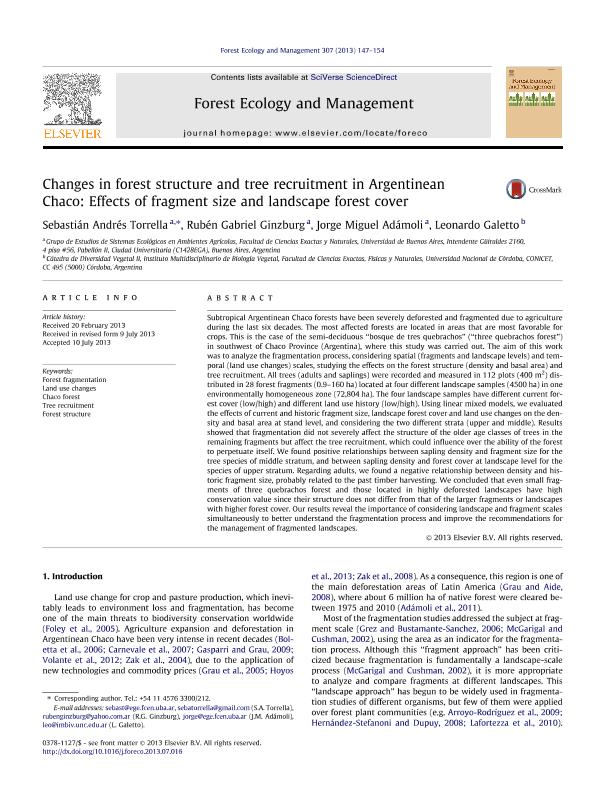Mostrar el registro sencillo del ítem
dc.contributor.author
Torrella, Sebastián
dc.contributor.author
Ginzburg, Rubén
dc.contributor.author
Adamoli, Jorge Miguel

dc.contributor.author
Galetto, Leonardo

dc.date.available
2017-02-07T17:52:17Z
dc.date.issued
2013-05
dc.identifier.citation
Torrella, Sebastián; Ginzburg, Rubén; Adamoli, Jorge Miguel; Galetto, Leonardo; Changes in forest structure and tree recruitment in Argentinean Chaco: Effects of fragment size and landscape forest cover; Elsevier Science; Forest Ecology And Management; 307; 5-2013; 147-154
dc.identifier.issn
0378-1127
dc.identifier.uri
http://hdl.handle.net/11336/12655
dc.description.abstract
Subtropical Argentinean Chaco forests have been severely deforested and fragmented due to agriculture during the last six decades. The most affected forests are located in areas that are most favorable for crops. This is the case of the semi-deciduous "bosque de tres quebrachos" (three quebrachos forest) in southwest of Chaco Province (Argentina), where this study was carried out. The aim of this work was to analyze the fragmentation process, considering spatial (fragments and landscape levels) and temporal (land use changes) scales, studying the effects on the forest structure (density and basal area) and tree recruitment. All trees (adults and saplings) were recorded and measured in 112 plots (400 m2) distributed in 28 forest fragments (0.9-160 ha) located at four different landscape samples (4500 ha) in one environmentally homogeneous zone (72,804 ha). The four landscape samples have different current forest cover (low/high) and different land use history (low/high). Using linear mixed models, we evaluated the effects of current and historic fragment size, landscape forest cover and land use changes on the density and basal area at stand level, and considering the two different strata (upper and middle). Results showed that fragmentation did not severely affect the structure of the older age classes of trees in the remaining fragments but affect the tree recruitment, which could influence over the ability of the forest to perpetuate itself. We found positive relationships between sapling density and fragment size for the tree species of middle stratum, and between sapling density and forest cover at landscape level for the species of upper stratum. Regarding adults, we found a negative relationship between density and historic fragment size, probably related to the past timber harvesting. We concluded that even small fragments of three quebrachos forest and those located in highly deforested landscapes have high conservation value since their structure does not differ from that of the larger fragments or landscapes with higher forest cover. Our results reveal the importance of considering landscape and fragment scales simultaneously to better understand the fragmentation process and improve the recommendations for the management of fragmented landscapes.
dc.format
application/pdf
dc.language.iso
eng
dc.publisher
Elsevier Science

dc.rights
info:eu-repo/semantics/openAccess
dc.rights.uri
https://creativecommons.org/licenses/by-nc-nd/2.5/ar/
dc.subject
Forest Fragmentation
dc.subject
Land Use Changes
dc.subject
Chaco Forest
dc.subject
Tree Recruitment
dc.subject.classification
Ecología

dc.subject.classification
Ciencias Biológicas

dc.subject.classification
CIENCIAS NATURALES Y EXACTAS

dc.title
Changes in forest structure and tree recruitment in Argentinean Chaco: Effects of fragment size and landscape forest cover
dc.type
info:eu-repo/semantics/article
dc.type
info:ar-repo/semantics/artículo
dc.type
info:eu-repo/semantics/publishedVersion
dc.date.updated
2017-01-31T17:49:30Z
dc.journal.volume
307
dc.journal.pagination
147-154
dc.journal.pais
Países Bajos

dc.journal.ciudad
Amsterdam
dc.description.fil
Fil: Torrella, Sebastián. Universidad de Buenos Aires. Facultad de Ciencias Exactas y Naturales. Departamento de Ecología, Genética y Evolución; Argentina
dc.description.fil
Fil: Ginzburg, Rubén. Universidad de Buenos Aires. Facultad de Ciencias Exactas y Naturales. Departamento de Ecología, Genética y Evolución; Argentina
dc.description.fil
Fil: Adamoli, Jorge Miguel. Universidad de Buenos Aires. Facultad de Ciencias Exactas y Naturales. Departamento de Ecología, Genética y Evolución; Argentina. Consejo Nacional de Investigaciones Científicas y Técnicas; Argentina
dc.description.fil
Fil: Galetto, Leonardo. Consejo Nacional de Investigaciones Científicas y Técnicas. Centro Científico Tecnológico Córdoba. Instituto Multidisciplinario de Biología Vegetal (p); Argentina
dc.journal.title
Forest Ecology And Management

dc.relation.alternativeid
info:eu-repo/semantics/altIdentifier/doi/http://dx.doi.org/10.1016/j.foreco.2013.07.016
dc.relation.alternativeid
info:eu-repo/semantics/altIdentifier/url/http://www.sciencedirect.com/science/article/pii/S0378112713004490
Archivos asociados
